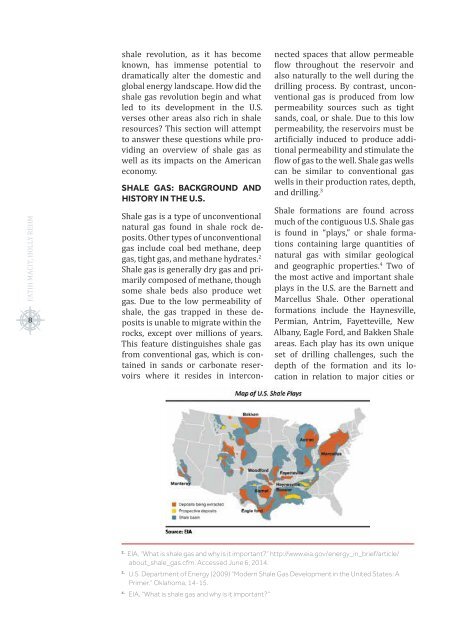Create successful ePaper yourself
Turn your PDF publications into a flip-book with our unique Google optimized e-Paper software.
FATIH MACIT, HOLLY REHM<br />
8<br />
shale revolution, as it has become<br />
known, has immense potential to<br />
dramatically alter the domestic and<br />
global energy landscape. How did the<br />
shale gas revolution begin and what<br />
led to its development in the U.S.<br />
verses other areas also rich in shale<br />
resources This section will attempt<br />
to answer these questions while providing<br />
an overview of shale gas as<br />
well as its impacts on the American<br />
economy.<br />
SHALE GAS: BACKGROUND AND<br />
HISTORY IN THE U.S.<br />
Shale gas is a type of unconventional<br />
natural gas found in shale rock deposits.<br />
Other types of unconventional<br />
gas include coal bed methane, deep<br />
gas, tight gas, and methane hydrates. 2<br />
Shale gas is generally dry gas and primarily<br />
composed of methane, though<br />
some shale beds also produce wet<br />
gas. Due to the low permeability of<br />
shale, the gas trapped in these deposits<br />
is unable to migrate within the<br />
rocks, except over millions of years.<br />
This feature distinguishes shale gas<br />
from conventional gas, which is contained<br />
in sands or carbonate reservoirs<br />
where it resides in interconnected<br />
spaces that allow permeable<br />
flow throughout the reservoir and<br />
also naturally to the well during the<br />
drilling process. By contrast, unconventional<br />
gas is produced from low<br />
permeability sources such as tight<br />
sands, coal, or shale. Due to this low<br />
permeability, the reservoirs must be<br />
artificially induced to produce additional<br />
permeability and stimulate the<br />
flow of gas to the well. Shale gas wells<br />
can be similar to conventional gas<br />
wells in their production rates, depth,<br />
and drilling. 3<br />
Shale formations are found across<br />
much of the contiguous U.S. Shale gas<br />
is found in “plays,” or shale formations<br />
containing large quantities of<br />
natural gas with similar geological<br />
and geographic properties. 4 Two of<br />
the most active and important shale<br />
plays in the U.S. are the Barnett and<br />
Marcellus Shale. Other operational<br />
formations include the Haynesville,<br />
Permian, Antrim, Fayetteville, New<br />
Albany, Eagle Ford, and Bakken Shale<br />
areas. Each play has its own unique<br />
set of drilling challenges, such the<br />
depth of the formation and its location<br />
in relation to major cities or<br />
2.<br />
EIA, “What is shale gas and why is it important” http://www.eia.gov/energy_in_brief/article/<br />
about_shale_gas.cfm. Accessed June 6, <strong>2014</strong>.<br />
3.<br />
U.S. Department of Energy (2009) “Modern Shale Gas Development in the United States: A<br />
Primer,” Oklahoma, 14-15.<br />
4.<br />
EIA, “What is shale gas and why is it important”










